- Home
- Diana Wynne Jones
Reflections: On the Magic of Writing Page 2
Reflections: On the Magic of Writing Read online
Page 2
I dig out beautiful caves behind my characters: I think that gives exactly what I want; humanity, humor, depth. The idea is that the caves shall connect and each comes to daylight at the present moment.1
This is true; but one of the many ways in which reading Diana does not resemble reading Virginia Woolf is that Diana gives her readers waymarks by which to navigate her text, Homeric epithets that conjure a character in a minimal number of words. What reader of Fire and Hemlock will forget that Polly’s granny’s house smells of biscuits, for example, and the way that this comes to symbolize the homely, reliable, sweet but highly nutritious nature of Granny herself? How potent a symbol are Chrestomanci’s flamboyant dressing gowns, denoting both wildness and yet a certain physical indolence? How irritatingly recognizable are helpful people who, like Joris in The Homeward Bounders, are always ready to reach into their jerkins and find some desired item with a “Why, as to that!” Yet none of these is a caricature or simply a collection of catchphrases. We never doubt that behind each surface lies a system of complex and beautiful caves.
Diana’s books have many subjects and many distinctive themes: language, imagination, storytelling, the recognition of talent in oneself, the ability to look beyond the obvious. If there is one that sums up the rest, however, perhaps it is that of empowerment—although I doubt whether Diana would have cared for the word. It is true that she also has a kind of affection for put-upon officials and for adults swept along by the tide of daily responsibilities. Their desire for respect, or at least feeling that they are not being positively laughed at, is one she treats with sympathy: one thinks of the anguished Sempitern Walker in A Tale of Time City, the earnest Rupert Venables from Deep Secret, or the harassed Wizard Corkoran in Year of the Griffin. But if there is a question of sides there can be no doubt that Diana is on the side of the powerless, the ones who have decisions taken and imposed upon them by others. And this, of course, usually means that she is on the side of children. As she has said, she aims to “provide a space where children can relax and walk round their problems and think ‘Mum’s a silly fusspot and I don’t need to be quite so enslaved by her notions.’” In a Diana Wynne Jones book, no orthodoxy or authority is above question. She is no nihilist—indeed, she has strong views about the responsibilities of the children’s author—but she is nevertheless one of the most thoroughly transgressive writers around.
All these qualities—her imaginative fertility, her range, her stamina, the breadth of her human sympathy and understanding, her command of plotting and of the other technicalities of the writer’s craft, along with her unquenchable curiosity about life and people—have given Diana a unique place, not just in literature for children or within speculative fiction, but in modern literature generally.
Diana did not write in a way that drew attention to her writing; she was more interested in the story that she wished to tell. However, anyone who met Diana or heard her speak will know that, for all the qualities evident in her work, she was also a keen thinker about writing. Her Tough Guide to Fantasyland is a piece of literary criticism disguised as a guidebook, and her fiction is shot through with insights into the power of words and the importance of their judicious deployment. Fire and Hemlock has important things to say about influence and originality, while “Carol Oneir’s Hundredth Dream” and Archer’s Goon make telling points about writer’s block. Besides these oblique contributions, however, she produced numerous essays and articles, as well as giving talks at conventions, schools, and conferences. The current volume gathers together much of that material. The wife, mother, and sister of professional academics, Diana was nevertheless ambivalent about the technical language of literary criticism, but as this volume demonstrates, she was a talented critic with important insights into her own work, that of other writers, and the creative process.
Diana’s essays and talks in this volume were written during the years from 1978 to 2008 and are arranged in a running order chosen by Diana. This is not strictly chronological but does reflect the development of her ideas. As she points out in her preface, in a collection such as this it is inevitable that certain anecdotes and experiences are mentioned more than once, since she recounted them to different audiences in various articles and talks. A recurrent topic is Diana’s childhood, a time when she learned the strangeness of human behavior and the arbitrariness of power, and when (living a life of neglect and emotional abuse with her two younger sisters) she began to craft imaginative worlds for her own benefit and theirs. Here too we see her beginning to piece together her ideas about the nature and purpose of fantasy, as symbolized in the two gardens kept by her parents—one dull and quotidian, the other magical, bee haunted, and securely locked. These symbols and experiences appear at various times throughout the volume, as does evidence of her early love of fantasy, epitomized in her preference for the “Piper at the Gates of Dawn” chapter in The Wind in the Willows, which was censored by her mother as being too fanciful. Given the occasional nature of the pieces in this volume, we have performed only a minimum of editing, leaving such reiteration of material as there is to speak naturally within its varying contexts. We hope that the result will be a cumulative appreciation of the role these ideas and experiences held in Diana’s thought.
For all their autobiographical content, the pieces in this volume are primarily concerned with writing. Some are about the art and craft of writing in general, and contain either observations about Diana’s writing life, or else practical advice to those who might wish to take up the profession. These include “The Children in the Wood,” “When I Won the Guardian Award,” “A Talk About Rules,” “Answers to Some Questions,” “A Whirlwind Tour of Australia,” “Some Hints on Writing,” “Characterization: Advice for Young Writers,” and, in a more oblique way, “Our Hidden Gifts.” Two others, “The Halloween Worms” and “A Day Visiting Schools,” deal with the adventures and misadventures that can happen to authors engaged in the tasks attendant on the professional life of a children’s writer, such as making school visits. In Diana’s case, such visits were always potentially charged with danger, due to a notorious travel jinx.
Another group of pieces focuses on Diana’s own work, either in general (“Creating the Experience,” “The Value of Learning Anglo-Saxon,” “Freedom to Write”) or else relating to specific works, as in “The Origins of The Merlin Conspiracy” and “The Origins of Changeover.” “Two Kinds of Writing?” explains Diana’s move into writing for adults with A Sudden Wild Magic, and includes some surprising thoughts about the differences between children and adults as readers. “The Heroic Ideal: A Personal Odyssey” is her most extended piece of analytical self-criticism and is a fascinating account of the ingredients that went into the making of Fire and Hemlock. Ideally, it should be read in tandem with “Some Truths About Writing,” a partial palinode for the earlier piece, which provides an alternative approach to the perennial question of where ideas come from, from a writerly rather than an academic perspective.
Apart from reviews Diana did not write much criticism of the work of others, but when she did so her major preoccupation was with the art of constructing and telling stories. “The Shape of the Narrative in The Lord of the Rings” is a sharp analysis of Tolkien, partly inspired by attending his lectures on plot construction as a student in the 1950s, while another of her lecturers is the subject of “Reading C. S. Lewis’s Narnia.” “Inventing the Middle Ages” describes the storytelling techniques that fascinate her in writers of the medieval period, many of whom haunt her own fiction through their example. Her work as a reviewer is represented here by a review of Mervyn Peake’s Boy in Darkness.
This book contains an interview Diana gave just a few weeks before her death. She was still very much interested in all the questions discussed in this volume, and still finding fresh ways to answer them. Besides its content, I hope that this interview captures something of how much fun a face-to-face conversation with Diana Wynne Jones could be.
Finally, thi
s collection includes pieces by two of Diana’s sons: an address given at her funeral ceremony, and a radio talk. Both show how her magical writings permeated and strengthened her family bonds. Together, the pieces in this book allow us to view Diana’s mind through various shades of enchanted glass and to enjoy its rare combinations of subtle thought and lucid expression, seriousness and humor, rootedness in the world and boundless imagination. They are not only valuable in themselves, but also serve as a vade mecum for anyone wishing to read—or perhaps reread—Diana Wynne Jones’s stories and novels. And that is a journey well worth taking.
—Charlie Butler
Preface
In 2009 I was told I had cancer. In 2010 I was told I had only a few months to live. Laura Cecil, who has been my agent ever since my first book for children was published, then felt it was time that we sorted out all my manuscripts in order to donate them to the archive Seven Stories. Since my handwritten first drafts often differ substantially from the printed book, she expected this would cast light on my working methods and so be of interest to future research.
We set to work. (The amount of dust that accumulates upon papers stored for up to thirty years in an unopened drawer surprised us both.) We discovered many things, some of them very odd, and, among them, a pile of the various lectures, articles, and reviews I had written between 1978 and 2008. These were, quite accidentally, stored more or less in chronological order, and as I looked through them, I realized that they provide a fairly complete picture of my growing ideas and convictions about writing for children, writing, and fantasy generally. They move from a discussion of Tolkien’s narrative, to reflections on my aims and methods, and then to efforts to describe and chart the creative process itself. Some items made me laugh as I reread them. People, I thought, might enjoy these. Then it occurred to me that this collection could amuse and interest students too, and might also be useful to teachers of creative writing and tutors of university courses on children’s literature and fantasy, of which there are now many.
Curiously enough, almost none of these items was spontaneous. Except for “The Children in the Wood,” which is an early meditation on the needs and habits of children, all the rest were requested by bodies in America and Australia as well as in Scotland, Ireland, and England. Nearly all these requests were for something amusing but serious in intent, which might lift the tone of an otherwise solemn conference. For instance, “Inventing the Middle Ages” was written for a conference at the University of Nottingham where contributors discussed the dialects of a number of small regions, the influence of the Vikings, the meter of medieval poetry, and suchlike topics. The organizer said she hoped I would approach the Middle Ages from an entirely different point of view, and I did my best to comply with this.
It is in the nature of such a collection of writings that certain facts and ideas tend to get repeated, although I hope not too often. As I do when writing a book, I tried, in each lecture or article, to present people with something different from what had gone before. In the process I found my own thinking expanding.
Some of the shorter items were requested by magazines for children. “When I Won the Guardian Award” was written for a children’s group in Rochdale, and likewise, I think, was “The Halloween Worms.” “Some Hints on Writing” and “Characterization: Advice for Young Writers” were both requested by the BBC for an educational website. The letter on the advantages of studying Anglo-Saxon at university is included because most people still do not believe how many highly respected writers have been inspired by learning the language and literature of that time. And, though I found I had written many reviews, I have only included one: of Boy in Darkness, by Mervyn Peake. I felt this was necessary as it is an account of the way even the most baroque fantasy can be directly relevant to ordinary life.
Various threads run through this collection, but by far the strongest is that of the need for fantasy in all its many facets and its value for children and adults alike. It is my hope that some of these items will be of use to people.
—Diana Wynne Jones
November 2010
The Children in the Wood
Written around the year 1981, this brief, personal story about narratives is, Diana says in her preface, one of the few articles she wrote that was not commissioned. Instead, she says, it is a “meditative” piece.
From my window I can see a steep stretch of woodland, which is really the garden of a big terrace of flats. I have watched it for five years now. It is full of children who appear to be mad. A group of girls totter down the slope. Each is wearing a skirt of her mother’s and holding a homemade crown onto her head. Every so often, they all stop and shake hands. Further along, another group of girls wanders among the bushes. Some bushes seem to terrify them. They clutch one another and scream. But they seem quite unaware of the bush beside them where three boys are crouching, armed with guns, and do not even look when one boy throws up both arms and dies. The girls in crowns seem equally unaware of four other boys struggling on their bellies up the gentle slope toward them. These boys seem to be in the last stages of exhaustion. One of the four dies as the girls pass, and the others roll back down the slope. The rest of the wood is full of similar groups. They are there day after day, tirelessly and all apparently insane.
Of course we all know at once that each group is playing a different game of Let’s Pretend. But anyone who watches this wood, or anywhere else where children habitually play, will quite soon notice a number of things, all of which ought to have great importance for anyone who is interested in writing for children.
The first thing is how often children play these kind of games. It seems to be something they need to do. You can see they need to, because they are all so happy. The second group of girls is only pretending to be frightened. None of the groups are quarreling or crying—only screaming, dying, or ignoring one another. The next most important fact is that the children are all in groups. In five years watching this wood I have scarcely ever seen a child obviously playing this kind of game alone. Solitary children do not act mad. He or she may be wandering in the wood imagining things, but it will not show. Acting out a Let’s Pretend game does seem to be a social act. I am sure that it is when I see how sexist the various games are. None of these children seem to have heard of women’s liberation. The girls say, “Let’s pretend we’re all queens,” and the boys, “Pretend we’re soldiers”—and though I haven’t a notion why the other girls are screaming at bushes, they are not playing with the boys. It really does seem as if Let’s Pretend games are children’s way of practicing being a girl or a boy—as they see it—as well as learning how to behave in a group.
You can see this is true when a quarrel breaks out. All the quarrels in the wood happen—with someone in tears and someone else bleating, “I’m not play-ying!”—when the children are trying to play a game like hide-and-seek or building a tree house, which does not involve make-believe. The rules allow both sexes to combine in these games. And it is hopeless. All children under about thirteen are so bad at cooperating. I watch them in exasperation, each one running about as if they were the only child there, without the slightest notion of how to get together with the rest. They really do seem to need some sort of Let’s Pretend to make them combine. And the thing which seems to allow them to get together is the thing which makes the games seem so mad to an onlooker: they at once seem to enter a sort of enchanted circle, where they are in control and nothing outside matters.
Now a book is another form of this enchanted circle. Any book, whether realistic or fantasy, is a self-contained world with the reader in control (if you do not like the game the writer is playing, you can always stop reading). My feeling is that children get most from books which work along the same lines as they do—in other words, by Let’s Pretend. I am not saying that a fantasy needs to ape children’s games, but I do think it should be not unlike them in a number of important respects. Above all, it should be as exciting and engrossing as the games in the
wood. I aim to be as gripped by a book I am writing as I hope any reader will be. I want to know what happens next. If it bores me, I stop. But a book has an additional asset: it seems to be real. If you say in a book that a certain thing is real, then in that book it is real. This is splendid, but it can also be a snare. I find I have to control any fantasy I write by constantly remembering the sort of things children do in their games.
Notice, for instance, that the children in the wood are very wisely not pretending too many things at once. They say “Pretend we’re all queens,” or “Pretend we’re explorers,” and part of the point of what follows is to find out what this entails. In the same way, I find it works best to suppose just one thing: Pretend you are a ghost, or Pretend your chemistry set works magic, or Pretend this dog is the Dog Star. Then I go on to explore the implications of this supposition. Quite often, I am totally surprised by the result.
I also bear constantly in mind the fact that pretending is a thing most usefully done in groups. It is done to show you how to get on with one another. When I write a book, it seems useful to extend the group to include both sexes, so that both girls and boys can enjoy it, but I do not find I can completely ignore the one-sex nature of the games in the wood. Oddly enough, this means that if I want a neutral character, not particularly girlish or boyish, I have to use a boy. A neutral girl would strike most girl readers as a tomboy. Otherwise, it is obvious that all other characters in a fantasy ought to be very real and clear and individual, and to interact profoundly—real, colorful people, behaving as people do. For instance, the first three girls who the ghost observes in The Time of the Ghost, strange as they are, are all drawn from life. One of them was me.

 Fire and Hemlock
Fire and Hemlock Reflections: On the Magic of Writing
Reflections: On the Magic of Writing The Game
The Game The Crown of Dalemark
The Crown of Dalemark Deep Secret
Deep Secret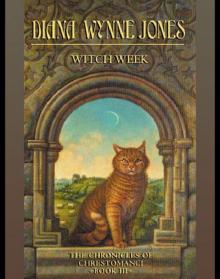 Witch Week
Witch Week Year of the Griffin
Year of the Griffin Wild Robert
Wild Robert Earwig and the Witch
Earwig and the Witch Witch's Business
Witch's Business Dogsbody
Dogsbody Caribbean Cruising
Caribbean Cruising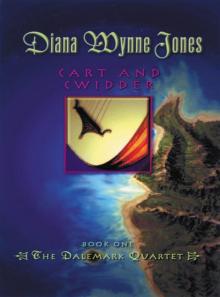 Cart and Cwidder
Cart and Cwidder Conrad's Fate
Conrad's Fate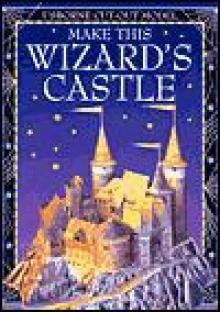 Howl's Moving Castle
Howl's Moving Castle The Spellcoats
The Spellcoats The Pinhoe Egg
The Pinhoe Egg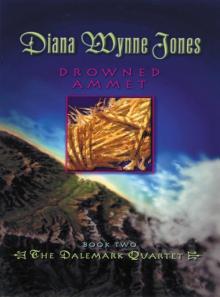 Drowned Ammet
Drowned Ammet The Ogre Downstairs
The Ogre Downstairs Dark Lord of Derkholm
Dark Lord of Derkholm Castle in the Air
Castle in the Air The Magicians of Caprona
The Magicians of Caprona A Tale of Time City
A Tale of Time City The Lives of Christopher Chant
The Lives of Christopher Chant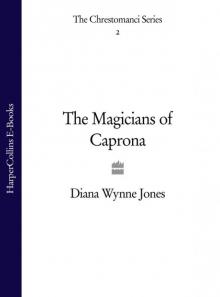 The Magicians of Caprona (UK)
The Magicians of Caprona (UK)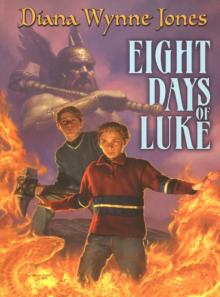 Eight Days of Luke
Eight Days of Luke Conrad's Fate (UK)
Conrad's Fate (UK)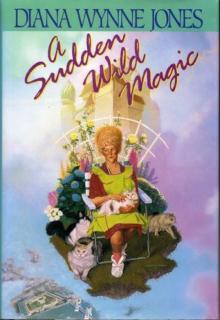 A Sudden Wild Magic
A Sudden Wild Magic Mixed Magics (UK)
Mixed Magics (UK) House of Many Ways
House of Many Ways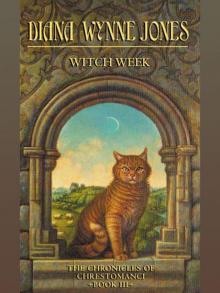 Witch Week (UK)
Witch Week (UK) The Homeward Bounders
The Homeward Bounders The Merlin Conspiracy
The Merlin Conspiracy The Pinhoe Egg (UK)
The Pinhoe Egg (UK) The Time of the Ghost
The Time of the Ghost Hexwood
Hexwood Enchanted Glass
Enchanted Glass The Crown of Dalemark (UK)
The Crown of Dalemark (UK)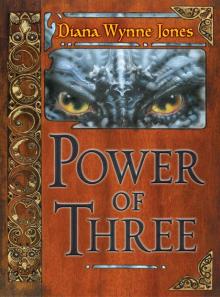 Power of Three
Power of Three Charmed Life (UK)
Charmed Life (UK) Black Maria
Black Maria The Islands of Chaldea
The Islands of Chaldea Cart and Cwidder (UK)
Cart and Cwidder (UK) Drowned Ammet (UK)
Drowned Ammet (UK) Charmed Life
Charmed Life The Spellcoats (UK)
The Spellcoats (UK) Believing Is Seeing
Believing Is Seeing Samantha's Diary
Samantha's Diary Aunt Maria
Aunt Maria Vile Visitors
Vile Visitors Stopping for a Spell
Stopping for a Spell Freaky Families
Freaky Families Unexpected Magic
Unexpected Magic Reflections
Reflections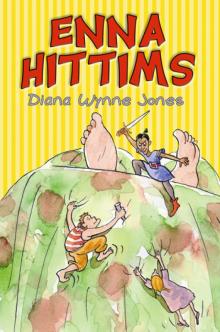 Enna Hittms
Enna Hittms Mixed Magics: Four Tales of Chrestomanci
Mixed Magics: Four Tales of Chrestomanci